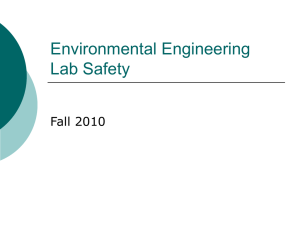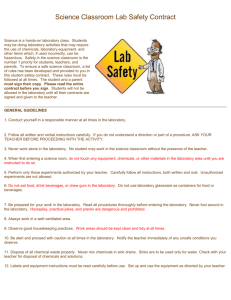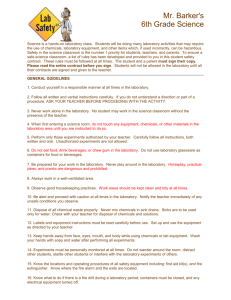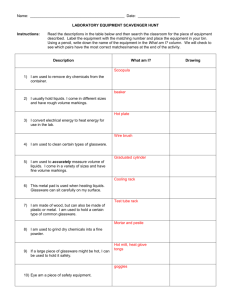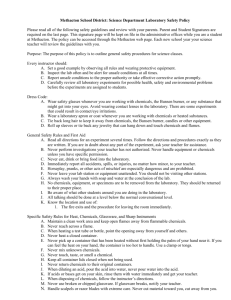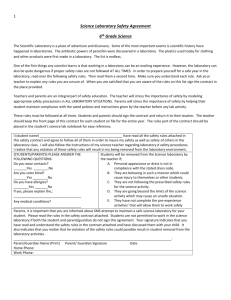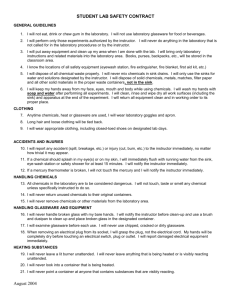lab orientation - Sergey Nizkorodov
advertisement
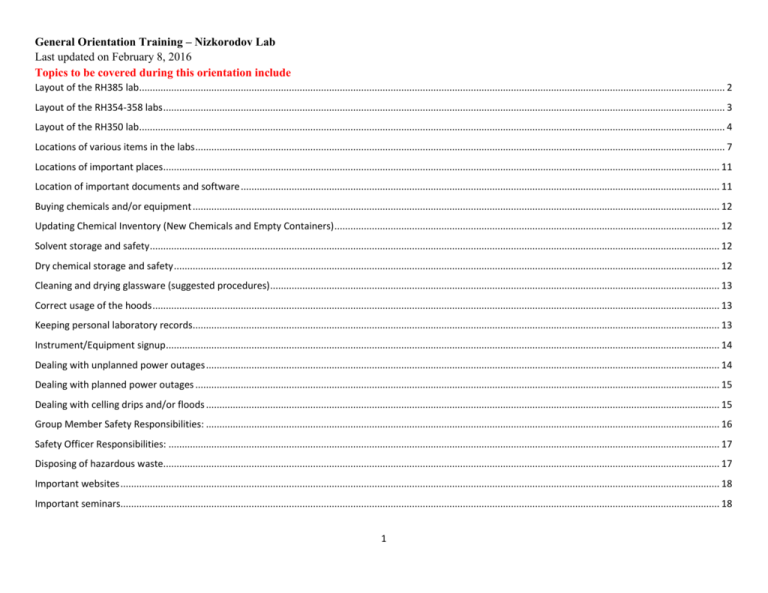
General Orientation Training – Nizkorodov Lab Last updated on February 8, 2016 Topics to be covered during this orientation include Layout of the RH385 lab........................................................................................................................................................................................................................... 2 Layout of the RH354-358 labs .................................................................................................................................................................................................................. 3 Layout of the RH350 lab........................................................................................................................................................................................................................... 4 Locations of various items in the labs ...................................................................................................................................................................................................... 7 Locations of important places................................................................................................................................................................................................................ 11 Location of important documents and software ................................................................................................................................................................................... 11 Buying chemicals and/or equipment ..................................................................................................................................................................................................... 12 Updating Chemical Inventory (New Chemicals and Empty Containers) ................................................................................................................................................ 12 Solvent storage and safety ..................................................................................................................................................................................................................... 12 Dry chemical storage and safety ............................................................................................................................................................................................................ 12 Cleaning and drying glassware (suggested procedures) ........................................................................................................................................................................ 13 Correct usage of the hoods .................................................................................................................................................................................................................... 13 Keeping personal laboratory records..................................................................................................................................................................................................... 13 Instrument/Equipment signup............................................................................................................................................................................................................... 14 Dealing with unplanned power outages ................................................................................................................................................................................................ 14 Dealing with planned power outages .................................................................................................................................................................................................... 15 Dealing with celling drips and/or floods ................................................................................................................................................................................................ 15 Group Member Safety Responsibilities: ................................................................................................................................................................................................ 16 Safety Officer Responsibilities: .............................................................................................................................................................................................................. 17 Disposing of hazardous waste................................................................................................................................................................................................................ 17 Important websites ................................................................................................................................................................................................................................ 18 Important seminars................................................................................................................................................................................................................................ 18 1 Layout of the RH385 lab 2 Layout of the RH354-358 labs 3 Layout of the RH350 lab 4 The previous pages provide images of the RH385, RH 350 and RH354-358 laboratories, to which we have access. During orientation you must familiarize yourself with the purpose of every bench, hood, storage cabinet, experimental area, etc. Guide: go over locations of these items (point out features of hoods like vacuum lines, etc.). Orientee: write down the purpose of the major locations in RH385: o Fume hoods: Hood 1 contains ______________________________________________________________________________________ Hood 2 contains _____________________________________________________________________________________ o Toxic gas bottle cabinets Toxic bottle cabinet 1 contains __________________________________________________________________________ Toxic bottle cabinet 2 contains __________________________________________________________________________ Purposes of benches vary based on projects. Make notes about the purpose of every bench: Bench 1 contains _____________________________________________________________________________________ Bench 2 contains _____________________________________________________________________________________ Bench 3 contains _____________________________________________________________________________________ Bench 4 contains _____________________________________________________________________________________ Bench 5 contains _____________________________________________________________________________________ Bench 6 contains _____________________________________________________________________________________ Bench 7 contains _____________________________________________________________________________________ Bench 8 contains _____________________________________________________________________________________ Cabinet 1 contains_____________________________________________________________________________________ Cabinet 2 contains ____________________________________________________________________________________ Cabinet 3 contains ____________________________________________________________________________________ o Benches o Cabinets 5 Orientee: write down the purpose of the major locations in RH350, 354, 358: o Fume hoods and glove boxes: RH358 hood contains __________________________________________________________________________________ RH350 hoods contain __________________________________________________________________________________ RH350 glove box contains ______________________________________________________________________________ RH358 bench contains _________________________________________________________________________________ RH350 benches contains ________________________________________________________________________________ RH358 cabinets contain________________________________________________________________________________ RH350 cabinets contain________________________________________________________________________________ o Benches o Cabinets o Refrigerators and Freezers in RH350 Refrigerator contains__________________________________________________________________________________ Freezer contains______________________________________________________________________________________ 6 Locations of various items in the labs Guide: review where these items are kept Orientee: write down their locations (e.g., “under bench 1”) Safety-related: o o o o o o o o o Eyewash and shower _____________________________________________________________________________________ Spill kit _______________________________________________________________________________________________ Gloves ________________________________________________________________________________________________ Tissues ________________________________________________________________________________________________ Cleaning supplies ________________________________________________________________________________________ Fire extinguisher _________________________________________________________________________________________ Safety glasses ___________________________________________________________________________________________ Broken glass container ____________________________________________________________________________________ Sharps container _________________________________________________________________________________________ Tools: o o o o o o Mechanical tools (wrenches, hammers, etc.) _____________________________________________________________________ Bolts and nuts ____________________________________________________________________________________________ Unistrut hardware __________________________________________________________________________________________ Propane torch for soldering __________________________________________________________________________________ Heat guns ________________________________________________________________________________________________ Epoxy and lubricants ________________________________________________________________________________________ Electrical: o o o o o o Multimeters ______________________________________________________________________________________________ Wires and hot shrink tubing __________________________________________________________________________________ Parts for making cables and various cables _______________________________________________________________________ Electrical plugs ____________________________________________________________________________________________ Propane torch for soldering __________________________________________________________________________________ Soldering supplies _________________________________________________________________________________________ 7 o o o o Heat guns ________________________________________________________________________________________________ BNC cables ______________________________________________________________________________________________ Extension cords ____________________________________________________________________________________________ New batteries and used batteries container _______________________________________________________________________ Chemicals and synthesis: o o o o o o o o o o o o o o o o o o o o o o o o o o Chemicals – solvents _____________________________________________________________________________________ Chemicals – solids _______________________________________________________________________________________ Chemicals – acids ________________________________________________________________________________________ Chemical waste __________________________________________________________________________________________ Chemicals needing refrigeration _____________________________________________________________________________ Synthesis supplies ________________________________________________________________________________________ Glassware – flasks ________________________________________________________________________________________ Glassware – volumetric ____________________________________________________________________________________ Glassware – beakers and Ernelmyers___________________________________________________________________________ Glassware – traps __________________________________________________________________________________________ Glassware – distillation ______________________________________________________________________________________ Glassware – large and unusual items ____________________________________________________________________________ Vials and bottles ___________________________________________________________________________________________ Pipettes (manual and automatic) ________________________________________________________________________________ Fridge/Freezer for chemicals ________________________________________________________________________________ Ovens_________________________________________________________________________________________________ Desiccators and dry boxes _________________________________________________________________________________ Stirplates and hotplates ____________________________________________________________________________________ Rotavap supplies _______________________________________________________________________________________ Nanopure water sources_____________________________________________________________________________________ Balances for chemicals only __________________________________________________________________________________ pH meter _______________________________________________________________________________________________ Shaker __________________________________________________________________________________________________ Purged glove box __________________________________________________________________________________________ Dewars __________________________________________________________________________________________________ Clamps __________________________________________________________________________________________________ 8 o Syringes _________________________________________________________________________________________________ Office-related: o o o o o o o Key for entering the lab if you locked yourself out (ask Sergey for the code) Fridge for food __________________________________________________________________________________________ Office supplies _________________________________________________________________________________________ Printers (do not use the color printer for mostly B&W printing) ___________________________________________________ Label printer Computer supplies ______________________________________________________________________________________ Paper and toners _________________________________________________________________________________________ Vacuum and flow: o o o o o o o o o o o o o o o o o o o Tubing – general purpose __________________________________________________________________________________ Tubing – conducting ______________________________________________________________________________________ Tubing – Teflon (for ozone only) ____________________________________________________________________________ Swagelok and other vacuum fittings __________________________________________________________________________ Mass flow controllers and rotameters__________________________________________________________________________ Pressure meters ___________________________________________________________________________________________ Purge air generators ________________________________________________________________________________________ KF flanges (for connecting pumps) ____________________________________________________________________________ Chambers and air filters ______________________________________________________________________________________ Pump oil __________________________________________________________________________________________________ Pump spare parts ___________________________________________________________________________________________ Chemicals – solids __________________________________________________________________________________________ Water filters ______________________________________________________________________________________________ Vacuum glass rack (for pumping on small volumes of liquid) ________________________________________________________ Valves ___________________________________________________________________________________________________ O-rings ___________________________________________________________________________________________________ Gas regulators ______________________________________________________________________________________________ Gillibrator flow calibrator _____________________________________________________________________________________ Vacuum grease ______________________________________________________________________________________________ 9 Aerosol synthesis and collection: o o o o o o o o o o o o o o Filters/MOUDI/other aerosol things _________________________________________________________________________ Sealer and Teflon sealing supplies ___________________________________________________________________________ Teflon roll (usually in the BFP group) _________________________________________________________________________ Balances for aerosol filters only ______________________________________________________________________________ Aerosol chamber supplies ___________________________________________________________________________________ Aerosol flow tube _________________________________________________________________________________________ Ozone generators _________________________________________________________________________________________ NOy box accessories_______________________________________________________________________________________ Ozone monitors ___________________________________________________________________________________________ SMPS ___________________________________________________________________________________________________ Atomizers ________________________________________________________________________________________________ Neutralizers _______________________________________________________________________________________________ Impactors (PIXE style) ______________________________________________________________________________________ Spare TSI parts ___________________________________________________________________________________________ Electronics and instruments: o o o o o o o HPLC instrument __________________________________________________________________________________________ GCMS instrument __________________________________________________________________________________________ UVVIS instruments _________________________________________________________________________________________ QCM instrument ___________________________________________________________________________________________ Various electronic instruments _______________________________________________________________________________ Power supplies ____________________________________________________________________________________________ MW generators and their supplies _______________________________________________________________________________ Radiation sources: o o o o o Replacement UV lamps _______________________________________________________________________________________ Laser supplies________________________________________________________________________________________________ Laser goggles ________________________________________________________________________________________________ Optics and optical mounts ______________________________________________________________________________________ UV illuminator supplies _______________________________________________________________________________________ 10 o Power meters ________________________________________________________________________________________________ o Ocean Optics spectrometers and parts_____________________________________________________________________________ ***Items specific to experiments are found in labeled drawers Locations of important places Guide: review where these places are located Orientee: write down their locations o o o o o o o o o o o Location of electrical breakers in every lab Other labs we use/share ____________________________________________________________________________________________ PS Stores (make sure orientee has an account) _________________________________________________________________________ Machine shop (explain how to place orders) ___________________________________________________________________________ Glassblowing shop (explain how to place orders) _______________________________________________________________________ Purchasing office (explain how to place orders) _________________________________________________________________________ Mass spectrometry facility (explain how to use) _________________________________________________________________________ Laser facility (explain how to use) OUR GROUP CODE IS: 199739_________________________________________________________ NMR facility (explain how to use)____________________________________________________________________________________ Meeting place for emergencies _______________________________________________________________________________________ Imageworks (for printing posters) _____________________________________________________________________________________ Location of important documents and software Guide: go over where these documents are kept Orientee: write down their locations o o o o o o o MSDS _________________________________________________________________________________________________ Lab’s standard operating procedures and instructions _____________________________________________________________ Shared group files (like IP addresses, birthdays, etc.) _____________________________________________________________ Purchase orders (POs – online versions and older paper versions )__________________________________________________ Instrument manuals _______________________________________________________________________________________ Company brochures _______________________________________________________________________________________ Group software disks _______________________________________________________________________________________ 11 Buying chemicals and/or equipment o o o o o Know your short and long budget code (each student has a separate one) Where to find and how to fill out a PO (purchase order) Where to buy things Gases – Airgas 800-224-7427 (tell them the ship to number = 1621651 and the room where bottles are to be deposited/picked up) Optics – Newport Optics Chemicals – Fisher (use username = uci; password = gofisher to show UCI prices; or Sigma Aldrich) Synthesis supplies (like TLC plates or glassware) – VWR (cheaper than Fisher) General supplies – McMaster Carr Swagelok – Orange Fluid Systems ***if you can’t find what you’re looking for with these companies, search the internet What to buy - review: very hazardous chemicals (check MSDS, is there another option?), chemical grades, chemical stability, etc. Receiving chemicals, transferring them to the inventory, an labeling them - SEE BELOW **buy only what you need (e.g. if you need 5 mL do not buy 500 mL!!! This is especially true if the chemical decomposes with time) Updating Chemical Inventory (New Chemicals and Empty Containers) o Refer to the document in the group dropbox titled “lab_chemical_inventory_instructions.docx” Solvent storage and safety o o o o Always wear gloves/goggles/labcoat when dealing with potentially-hazardous chemicals. Solvents are kept in ventilated cabinets below hoods 1-2, and benches 1-3. There are separate cabinets for storage of flammables, flammable/general, toxics, corrosives, and oxidizers. Several squirt bottles are available for solvents. Use organic solvents IN THE HOOD. Water can use used outside the hood. Dry chemical storage and safety Always wear gloves/goggles/labcoat when dealing with potentially-hazardous chemicals. o o General dry chemicals are stored in the cabinet in RH350. Some dry chemicals that need to be kept cool are stored in the RH 350 fridge. Dry chemicals that are hazardous (and/or smelly) must be weighed out IN THE HOOD (unplug and turn off the balance, relocate the balance to the hood, plug in/turn on and weigh) 12 Reminder: Although silica gel looks harmless, it should always be weighed out in the hood because the particles can get into your lungs and damage the tissue. Cleaning and drying glassware (suggested procedures) o o o Glassware that contained pure organic compounds– wash with suitable organic solvent a few times and air dry or oven dry. Glassware that is dirty – General procedure: Soak in a bath of Liquinox solution for at least 15 minutes. Scrub well with glassware brush. Rinse well with tap water. Rinse again with DI water. Rough rinse with acetone (reuse the acetone for subsequent pieces). Final rinse with acetone and oven dry. Glassware that needs to be critically cleaned – Acid procedure 1– coat glassware with concentrated sulfuric acid and let sit for at least 30 min. Rinse carefully and thoroughly with tap water and keep rinse water in a large waste container. Neutralize both liquid in the glassware and waste container with sodium bicarbonate until pH 7. Discard neutralized water down the drain. Rinse clean glassware with DI water and dry. Acid procedure 2 – make up a strongly acidic solution and soak glassware for 1 hour. Remove glassware and save solution in a suitable container. Place glassware in a large bucket of water. Neutralize the water in the bucket with the sodium bicarbonate. Rinse glassware with DI water and dry. Permanganate – make a concentrated potassium permanganate solution and place in a large (1 L or larger) beaker until 70% full. Boil your glassware in the permanganate solution for 1 hour. Remove glassware and place in a dilute H2O2 bath, save the permanganate solution for future use. Rinse glassware with DI water and dry. Correct usage of the hoods o o o o o Hood lights should be ON whenever in use Hood ventilation should be working Don’t block the hood sash from closing all the way (feed lines underneath) Don’t use the hoods as a storage place for old chemical solutions. If vials/containers have been there for months without use, get rid of it or store in a proper place (the fridge for example). At the end of the day, TURN OFF the hood lights and CLOSE the hood sash Keeping personal laboratory records Guide: Make sure orientee has a laboratory notebook! You can buy one in the PS stores (Sergey may have new notebooks stored in his office). Show orientee an example of laboratory notes. 13 Keeping laboratory records is mandatory! Your memory cannot be trusted, so record your experiment in detail every time. Things to record: o o o o o o o o Date of experiment Instruments used and their settings Drawing/sketch/photo of setup the first time you used it Chemicals (where you obtained them, purity, structure and formula, MW, etc.) Weights/volumes/etc of all materials used – e.g., glassware or vials, chemicals, etc. Initial conditions before experiments ALL observations made at ANY time during experiment Final conditions after experiments Instrument/Equipment signup These instruments require sign-up: o o o o PTR-ToF-MS (online Google Doc) ToF-AMS (online Google Doc) UV-Vis (online Google Doc) Chamber (online Google Doc) Dealing with unplanned power outages If an unexpected power outage happens, QUICKLY: o o o o o Shut down your computer (if it is power by an UPS) Close all compressed cylinders Lower the hood sashes Stop chamber purge Quickly shut shown all the instruments connected to UPS: PTR-MS computer and spectrometer CIMS computer, mass-spectrometer, turbo pumps, diaphragm pumps, MFC controllers UV/Vis instruments and their computers GCMS instrument and its computer HPLC instrument and its computer 14 o SMPS instruments and their computers Both CRDS computers For all instruments with on/off switches set the switches to the off position (or unplug them) – otherwise they may die when the power comes back CRDS oscilloscope, delay generator, MFC controller, baratron controller Xe-lamp power supplies Chamber NOy monitor (also unplug its pump) Chamber O3 monitor Chamber MOUDI Chamber filter pump TDMA high-voltage power supplies Dealing with planned power outages Turn off equipment in the following order: 1. CIMS turbo pumps (water cooled) and Extel electronics 2. Booster pump (water cooled) and mechanical pump in the 3rd floor chase 3. Large Nd:YAG laser 4. Water circulator in the 4th floor chase (CIMS turbos must finish spinning down since they are being cooled by this water) 5. Close all gas flows and all gas bottles; close the inlet air for all zero-air generators 6. Turn off all mechanical pumps 7. Turn off all stand-alone equipment (see list above) 8. Disable all UPS (so that they do not switch to emergency power) and turn them off or unplug them 9. For all instruments with on/off switches set the switches to the off position (or unplug them) 10. Unplug all expensive equipment from wall outlets 11. If the power outage is expected to be longer than 1 hour move all chemicals from the refrigerator to dry-ice cooled boxes and defrost the refrigerators during the power outage Dealing with celling drips and/or floods o If the ceiling begins to drip or the lab floods, it is important to prevent water damage to equipment (especially ones that are difficult to move). o Power down the corresponding equipment, but make sure it is safe to do so (i.e. you won’t electrocute yourself by unplugging it because water is near the electrical input of the equipment). 15 o Place a piece of polyethylene (it is in sheet form rolled up in a box above the large toolbox in RH385) over the equipment that is affected. Group Member Safety Responsibilities: o o o o o o o WASTE DISPOSAL: Everyone in the group is responsible for the waste they generate. Make sure to label all waste containers appropriately. For more information on how to store and label waste, please refer to the “Disposing of waste” section of this orientation document. Request a pickup from EH&S within 6 months of the start date of the waste generation (waste pickup requests will be submitted by different group members on a rotating basis to spread the load equally). NEW HAZARDOUS CHEMICAL: If you are using a chemical that our lab has not yet used, make sure to follow the appropriate channels. This involves: reading the SDS for the specific chemical, checking the EH&S webpage to see if it needs a special SOP, and following any and all specific safety requirements from the appropriate agency(ies). If you need assistance with creating an SOP, notify the safety officer. USING AN INSTRUMENT/CHEMICAL FOR THE FIRST TIME: If you are using a chemical/instrument for the first time, make sure you have read all appropriate documentation, have been trained in its operation, and have signed all appropriate documentation in the safety binders PERSONAL PROTECTIVE EQUIPMENT (PPE): Always make sure to wear the proper PPE for any experiment you are performing. Check the SDS/SOP/etc. for specifics. GENERAL RULES: Safety is the top priority in the lab. Use common sense and if in doubt about anything, do not perform the experiment/ask for assistance!!! UNSAFE PROCEDURES: if you see a group member doing something obviously dangerous stop him/her right away and suggest a saferprocedure. Keep an eye on the following: HOOD SASH: If the hood sash was accidentally left raised too high lower it. HOOD FAILURE: if the hood is beeping, reset the hood, lower the sash, and verify that the lab has negative pressure. Notify facilities if beeping resumes. UNSAFE POWER LINES: if you see frayed or entangled power lines alert the person responsible for this section of the lab. CIMS TURBO PUMPS: if they are blinking red and/or have stopped spinning it probably means that the water circulator in the 4th is low on water and stopped. Refill it with water following the SOP and restart the circulator and the pumps. CIMS DIAPHRAGM PUMPS: if they are noisier than usual or appear to have stopped turn the turbo pumps off by pressing on the button in the bottom right corner of the front panel, and turn off the diaphragm pumps. Alert Sergey. WATER LEAKS: if you see water leaking from the lab water circulation lines, turn off laser, CIMS turbos, and booster pump in the 3rd floor chase immediately. 16 UPS FIALURES: if the uninterruptable power supply is beeping, reset it and notify Sergey. It is time to replace the battery. CHILLERS/HEATERS: if you see water or ethanol flowing for the circulating bath heaters/coolers, turn them off immediately! Safety Officer Responsibilities: o The safety officer (Student Representative or SR) serves as a conduit of information among the campus safety organizations, group members, and the principle investigator. o The specific responsibilities include: Completing the Laboratory Hazard Identification checklist annually and helping to ensure that identified hazards are corrected and addressed. Helping group members create Standard Operating Procedures (SOPs). Ensuring that group members complete all required training. Help coordinate work unit specific training for new and existing members as necessary. Maintain written records for the above (i.e. the Safety Binders). o Additionally, the safety officer will periodically check the laboratories for potential safety hazards, but the ultimate responsibility for safety will be the individual performing the work!!! Disposing of hazardous waste o o o o o o o o Liquid chemical waste - each hood has liquid chemical waste bottles that you can deposit waste into. Make sure to note the difference between aqueous waste and organic waste. There are a few types of organic waste bottles. **Common solvent waste** - common solvents used for washing like acetone has its own waste bottle. These types of wastes are to be redistilled with a Rotary Evaporator (bath temp ~ 30 C) to recycle the clean solvent and then only used for washing. Solid chemical waste – these types of waste should be dissolved into the solvent it is compatible with and disposed in the liquid waste. Solid non-chemical hazardous waste – solids contaminated with chemicals but does not dissolve (e.g., silica gel) needs its own waste container that EH&S will supply and pick up separately. Solid non-chemical non-hazardous waste – these go in the trash. Glass waste and non-glass waste that needs to be incinerated go into the glass container. Do not put bottle from drinks into the glass container. Razors and other sharps go into the sharps container. 17 o Batteries go into the battery container to be recycled. Important websites Guide: go to a computer and show how to access these websites, go over what they are used for. Orientee: write down the main function o o o o o o o o o Group website ________________________________________________________________ Intranet and group chemical inventory _______________________________________________________ Chemical inventory of UCI Physical Sciences (cheminnovation) __________________________________________________ PS Stores inventory __________________________________________________ Any online sign-up sheets __________________________________________________ Scifinder , Web of Science, Google Scholar __________________________________________________ NIST chemical webbook __________________________________________________ CRC Chemical handbook __________________________________________________ Important journals like ACP, EST, etc. __________________________________________________ Important seminars o o o Group seminar (weekly on dates posted on group website in RH 390)– mandatory AirUCI seminar (biweekly on Tuesday at 12 pm in RH 390) – mandatory Pchem seminar (weekly on Tuesdays at 4 pm in RH 401) – optional but highly-recommended when there is a talk relevant to atmospheric science 18

